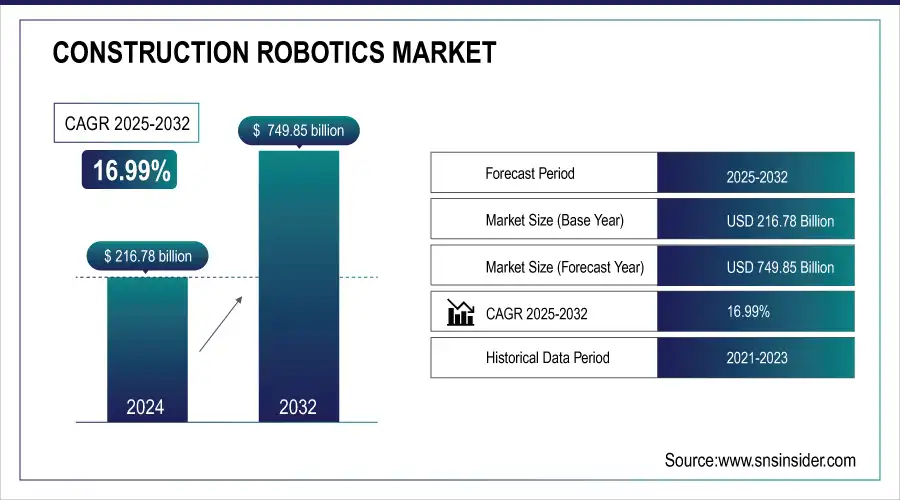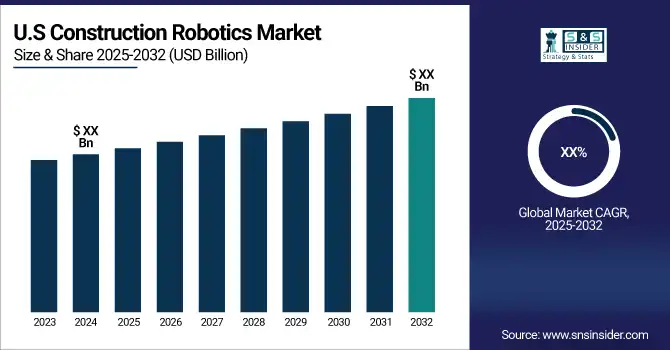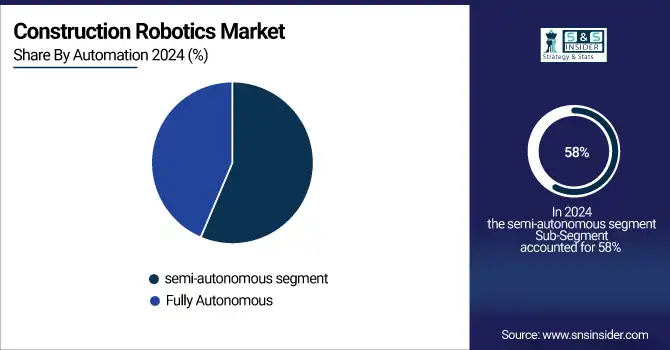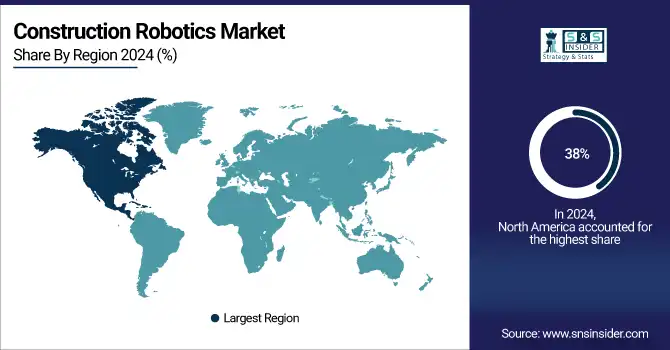Construction Robotics Market Size & Trends:
The Construction Robotics Market Size was valued at USD 216.78 billion in 2024 and is expected to reach USD 749.85 billion by 2032, growing at a CAGR of 16.99% from 2025-2032.
The construction robotics market is experiencing significant expansion, propelled by progress in automation and robotics technology and the growing demand for efficiency in construction methods. As the need for quicker project finishes, economical building techniques, and enhanced worker safety grows, robotic systems are becoming essential in contemporary construction methods. These systems, encompassing robotic arms, self-driving vehicles, drones, and 3D printing technologies, are being utilized in different construction areas, including bricklaying, demolition, and concrete printing. The worldwide emphasis on sustainable building increases the implementation of robotics to enhance material efficiency and minimize environmental effects.

To get more information on Construction Robotics Market - Request Free Sample Report
Construction Robotics Market Size and Forecast:
-
Market Size in 2024: USD 216.78 Billion
-
Market Size by 2032: USD 749.85 Billion
-
CAGR: 16.99% from 2025 to 2032
-
Base Year: 2024
-
Forecast Period: 2025–2032
-
Historical Data: 2021–2023

Key Construction Robotics Market Trends:
-
Automation of repetitive construction tasks such as bricklaying, concrete pouring, and welding improves productivity and reduces labor dependency.
-
Integration of artificial intelligence and machine learning enables advanced robotics to adapt to dynamic construction environments and improve precision.
-
Adoption of 3D printing and robotic additive manufacturing accelerates modular construction and reduces material wastage.
-
Growing use of drones and autonomous vehicles enhances site surveying, safety monitoring, and logistics management.
-
Collaborative robots (cobots) gain traction for assisting human workers in heavy lifting, drilling, and assembly.
-
Rising demand for demolition and rehabilitation robots addresses safety concerns in hazardous construction zones.
-
Deployment of exoskeletons supports worker safety and efficiency in physically demanding construction activities.
The need for construction robotics is strengthened by labor shortages in numerous nations, as the sector encounters difficulties in drawing a skilled workforce. Robots assist in closing this gap by assuming repetitive, labor-intensive duties, allowing human workers to concentrate on more intricate aspects of construction. Moreover, progress in artificial intelligence, IoT integration, and sensor technologies has improved the performance and dependability of robotic systems, increasing their accessibility and scalability for both small and large construction projects. Komatsu presented its state-of-the-art innovations at CES 2025, revealing concepts for lunar construction machinery and underwater robotics, highlighting the company’s inaugural participation in the event.
The prospects for the construction robots market are vast, fueled by continuous research and development that promotes innovation. Self-driving construction machinery and cooperative robots are set to revolutionize construction site operations, facilitating instantaneous data gathering, accurate tasks, and improved project oversight. Developing economies, especially in the Asia-Pacific and the Middle East, are anticipated to become key centers of growth because of swift urbanization and infrastructure advancement. In addition, investments from both public and private sectors in smart cities and infrastructure initiatives will persist in driving the need for construction robotics, leading to a more automated and efficient building environment.
Construction Robotics Market Drivers:
-
Robotics is solving labor shortages and reducing costs in construction by automating repetitive tasks and improving efficiency.
Labor shortages and escalating labor costs are significant challenges facing the construction industry worldwide. Many regions are experiencing a decline in skilled workers due to an aging workforce and a lack of interest from younger generations in pursuing construction careers. This shortage not only slows project timelines but also drives up labor expenses, making traditional construction methods less sustainable. Robotics provides an innovative solution to these challenges by automating repetitive, labor-intensive tasks, such as bricklaying, material handling, and demolition. These technologies reduce dependency on human labor, enabling construction companies to maintain productivity while minimizing costs. Additionally, robots can work around the clock, ensuring consistent and efficient output. By addressing these critical workforce issues, robotics is playing a pivotal role in transforming and future-proofing the construction industry.
-
Rapid Urbanization and Infrastructure Growth Drive the Adoption of Construction Robotics Across Emerging and Developed Economies
The rapid pace of urbanization, particularly in emerging economies, is significantly boosting the demand for construction robotics. As cities expand to accommodate growing populations, the need for residential, commercial, and industrial infrastructure is at an all-time high. Governments and private sector players are heavily investing in innovative construction solutions to accelerate project timelines while ensuring quality and sustainability. Construction robotics, including automated machinery, drones, and 3D printing technologies, are proving vital in meeting the challenges of large-scale urban development. These robots enhance efficiency, reduce labor dependency, and optimize resource use, making them indispensable for smart city and infrastructure projects. With urbanization trends showing no signs of slowing down, construction robotics is set to play a central role in shaping the future of global infrastructure.
Construction Robotics Market Restraints:
-
High maintenance and operational costs of construction robots limit adoption, impacting profitability and return on investment for companies.
While construction robots significantly improve efficiency and productivity, their high maintenance and operational costs act as a key restraint for the market. Regular maintenance, repair, and software updates are essential to ensure the optimal performance of these advanced machines. However, these ongoing costs can quickly add up, especially for small and medium-sized construction companies with limited budgets. In addition to financial burdens, the need for specialized technicians to manage repairs and updates further complicates adoption. The high costs associated with maintaining robotic systems also impact the return on investment, making some construction firms hesitant to invest in these technologies. Until more cost-effective maintenance solutions are developed, the high operational expenses of construction robotics will remain a challenge to widespread implementation in the industry.
Construction Robotics Market Segmentation Analysis:
By Automation, Semi-autonomous systems dominate, while fully autonomous robotics is set to grow fastest
In 2024, the semi-autonomous segment dominated the construction robotics market, capturing approximately 58% of the revenue share. This dominance can be attributed to the balance these systems offer between advanced automation and human control. Semi-autonomous robots are cost-effective compared to fully autonomous systems and are easier to integrate into existing workflows, making them an appealing choice for construction companies looking to improve efficiency without incurring prohibitive costs. Additionally, these robots provide enhanced precision and safety while allowing human oversight, which is particularly valuable for complex, unstructured tasks on construction sites.
The fully autonomous segment is expected to grow at the fastest CAGR of about 18.24% from 2025 to 2032, driven by rapid advancements in artificial intelligence, machine learning, and sensor technologies. Fully autonomous robots offer unparalleled efficiency by performing tasks with minimal human intervention, reducing labor costs and accelerating project timelines. The growing demand for smart cities and large-scale infrastructure projects further fuels their adoption, as these robots can seamlessly operate in dynamic environments. As construction companies seek to meet increasing project complexities and labor shortages, fully autonomous systems are positioned as a transformative solution in the industry's future.

By Function, Material handling leads, demolition robotics forecasted as fastest-growing segment
In 2024, the material handling segment led the construction robotics market, capturing approximately 35% of the revenue share. This dominance is attributed to the high demand for automated solutions in transporting, lifting, and placing heavy construction materials, which are critical tasks on most job sites. Material handling robots significantly enhance efficiency, reduce manual labor costs, and improve worker safety by automating repetitive and strenuous activities. Their versatility and widespread applicability across various construction projects further reinforce their market leadership.
The demolition segment is anticipated to grow at the fastest CAGR of 26.53% from 2025 to 2032, driven by the increasing adoption of robotic systems for complex and hazardous demolition tasks. These robots offer precision, safety, and cost-efficiency, making them ideal for handling high-risk jobs in urban environments and confined spaces. Rising global infrastructure redevelopment projects and stricter safety regulations are also accelerating demand for demolition robots, positioning them as a key growth driver in the construction robotics market.
By End-use, Industrial construction dominates, residential segment expected to grow at highest CAGR
In 2024, the industrial segment dominated the construction robotics market, accounting for approximately 43% of the revenue share. This leadership is driven by the extensive use of robotics in large-scale industrial projects such as factories, warehouses, and power plants, where efficiency and precision are critical. Industrial projects often involve heavy materials and repetitive tasks, making them ideal for automation through advanced robotics. The segment's dominance is further supported by consistent investments in infrastructure development and the need for higher productivity in industrial construction.
The residential segment is projected to grow at the fastest CAGR of 18.64% from 2025 to 2032, fueled by rising demand for housing and urbanization worldwide. Robotic solutions are increasingly being adopted for tasks such as bricklaying, painting, and material handling in residential projects to meet the need for faster and cost-effective construction. Additionally, the push for sustainable and smart home developments is driving interest in robotics, as these technologies enhance precision and reduce waste. The combination of labor shortages and growing consumer expectations for quality is further accelerating the adoption of robotics in residential construction.
Construction Robotics Market Regional Analysis:
North America Dominates Construction Robotics Market in 2024
North America holds an estimated 38% market share in 2024, driven by high labor costs, skilled workforce shortages, and rapid adoption of automation technologies. This causes construction companies to integrate robotics for efficiency, cost savings, and enhanced safety, particularly in large-scale infrastructure projects.

Get Customized Report as per Your Business Requirement - Enquiry Now
-
United States Leads North America’s Construction Robotics Market
The U.S. dominates due to its large infrastructure investments, advanced robotics ecosystem, and strong government support for automation and smart city projects. Federal and state funding accelerates the adoption of semi-autonomous and fully autonomous systems in industrial, commercial, and residential projects. Leading companies collaborate with technology innovators to deploy 3D printing, demolition, and material-handling robots. With high R&D spending, mature construction firms, and emphasis on productivity, the U.S. remains the largest contributor to North America’s construction robotics leadership.
Asia Pacific is the Fastest-Growing Region in the Construction Robotics Market in 2024
The region is expected to grow at a CAGR of 21.3% from 2025–2032, driven by rapid urbanization, infrastructure megaprojects, and government-backed smart city initiatives. This causes construction companies to adopt advanced robotics for speed, precision, and efficiency in meeting rising project demand.
-
China Leads Asia Pacific’s Construction Robotics Market
China dominates the Asia Pacific market due to massive infrastructure projects, strong urbanization, and government investments in robotics and smart construction. National policies promoting digitalization and smart cities accelerate the adoption of 3D printing, demolition, and fully autonomous robots. Local robotics manufacturers, combined with global partnerships, strengthen the country’s leadership. With a focus on automation, cost reduction, and technology innovation, China sets benchmarks in robotics deployment, making it the hub of construction robotics development in the region.
Europe Construction Robotics Market Insights, 2024
Europe is witnessing strong adoption of construction robotics, fueled by EU sustainability goals, labor shortages, and a focus on digital transformation. Germany’s strong emphasis on Industry 4.0 integration and robotics adoption improves construction efficiency, causing faster market penetration across Europe.
-
Germany Leads Europe’s Construction Robotics Market
Germany dominates the European market with advanced construction practices, precision engineering, and government-backed automation initiatives. High labor costs and a strong industrial robotics base accelerate adoption of semi-autonomous systems in material handling, demolition, and industrial projects. Investments in smart infrastructure and collaboration between construction firms and technology providers further boost growth. Germany’s leadership in digital construction solutions and robotics innovation cements its position as Europe’s construction robotics powerhouse.
Middle East & Africa and Latin America Construction Robotics Market Insights, 2024
The Construction Robotics Market in these regions is expanding steadily, supported by megaprojects, housing demand, and urbanization. The UAE and Saudi Arabia lead in the Middle East with investments in smart city projects such as NEOM, driving robotic integration in construction. Africa is gradually adopting automation in urban infrastructure development. In Latin America, Brazil and Mexico lead growth through housing expansion and government-backed infrastructure modernization. International collaborations and foreign investments are accelerating robotics adoption, creating opportunities across both regions.
Competitive Landscape for Construction Robotics Market:
ABB
ABB is a Switzerland-based global technology leader in automation and robotics, delivering advanced solutions for the construction industry. The company provides robotic arms, autonomous systems, and AI-driven platforms that enhance precision, safety, and efficiency across various construction processes. ABB’s construction robotics portfolio includes material handling, 3D printing, and demolition applications, integrating seamlessly with digital twin and Industry 4.0 ecosystems. Its role in the construction robotics market is significant, as it empowers contractors and developers to automate complex workflows, reduce labor dependency, and accelerate project timelines while meeting sustainability and safety standards.
-
In 2024, ABB launched its new robotic automation platform designed for construction sites, combining AI, vision systems, and autonomous mobility to improve on-site productivity and precision in large-scale infrastructure projects.
Advanced Construction Robots
Advanced Construction Robots is a U.S.-based innovator specializing in semi-autonomous and fully autonomous robotic systems for the construction sector. The company designs robots capable of performing high-risk and labor-intensive tasks such as drilling, tying rebar, and site monitoring. Its solutions integrate sensors, AI, and machine learning, ensuring greater accuracy, safety, and cost-effectiveness. Advanced Construction Robots plays a vital role in advancing robotic adoption on construction sites by providing user-friendly automation tools that complement human workers and enhance productivity. Its systems are widely adopted in commercial, residential, and industrial construction projects.
-
In 2024, Advanced Construction Robots introduced its next-generation semi-autonomous rebar-tying robot, designed to operate in dynamic environments while reducing repetitive strain injuries and improving labor efficiency.
BROKK GLOBAL
BROKK GLOBAL is a Sweden-based leader in remote-controlled demolition robots, with decades of expertise in developing compact, powerful machines for construction and mining industries. The company specializes in lightweight yet highly efficient robotic demolition systems that enhance worker safety in hazardous environments such as confined spaces, nuclear plants, and urban construction sites. BROKK GLOBAL’s role in the construction robotics market is central, as its solutions replace manual demolition tasks with precision-driven automation, reducing risks and increasing efficiency. With a global presence, BROKK GLOBAL sets benchmarks for robotic demolition technology.
-
In 2024, BROKK GLOBAL expanded its product line with a new generation of demolition robots equipped with enhanced hydraulics and AI-assisted remote control, improving both speed and operational safety.
Ekso Bionics
Ekso Bionics is a U.S.-based pioneer in wearable robotic exoskeletons for industrial and construction applications. The company develops advanced exoskeleton systems designed to augment human strength, reduce fatigue, and prevent injuries during heavy lifting and repetitive tasks. Ekso Bionics’ solutions integrate biomechanics and robotics, enabling construction workers to handle physically demanding activities with enhanced safety and endurance. Its role in the construction robotics market is vital, bridging the gap between human labor and robotics to improve workforce efficiency and wellbeing on-site. The company continues to expand its global partnerships to advance worker-centric automation.
-
In 2024, Ekso Bionics unveiled its new industrial exoskeleton, optimized for construction applications, offering improved ergonomics and reducing musculoskeletal strain among workers handling heavy materials.
Construction Robotics Market Key Players:
-
ABB
-
BROKK GLOBAL
-
Ekso Bionics
-
MX3D
-
FBR Ltd
-
Conjet
-
Komatsu Ltd.
-
Fujita Corporation
-
Contour Crafting Corporation
-
CyBe Construction
-
KEWAZO
-
RobotWorx
-
Built Robotics
-
ICON Technology, Inc.
-
Dusty Robotics
-
MUDBOTS 3D CONCRETE PRINTING, LLC
-
Advanced Construction Robotics, Inc.
| Report Attributes | Details |
|---|---|
| Market Size in 2024 | USD 216.78 Billion |
| Market Size by 2032 | USD 749.85 Billion |
| CAGR | CAGR of 16.99% From 2025 to 2032 |
| Base Year | 2024 |
| Forecast Period | 2025-2032 |
| Historical Data | 2021-2023 |
| Report Scope & Coverage | Market Size, Segments Analysis, Competitive Landscape, Regional Analysis, DROC & SWOT Analysis, Forecast Outlook |
| Key Segments | • By Type(Aboveground Storage Tanks, Underground Storage Tanks) • By Product(Hazardous, Non-Hazardous) • By Material(Steel, Concrete,Polyethylene,Others) • By Application(Oil & Gas, Chemicals, Water, Food and Beverage, Others) |
| Regional Analysis/Coverage | North America (US, Canada, Mexico), Europe (Eastern Europe [Poland, Romania, Hungary, Turkey, Rest of Eastern Europe] Western Europe] Germany, France, UK, Italy, Spain, Netherlands, Switzerland, Austria, Rest of Western Europe]), Asia Pacific (China, India, Japan, South Korea, Vietnam, Singapore, Australia, Rest of Asia Pacific), Middle East & Africa (Middle East [UAE, Egypt, Saudi Arabia, Qatar, Rest of Middle East], Africa [Nigeria, South Africa, Rest of Africa], Latin America (Brazil, Argentina, Colombia, Rest of Latin America) |
| Company Profiles | ABB , Advanced Construction Robots , BROKK GLOBAL , Ekso Bionics , Autonomous Solutions Inc. , MX3D , Husqvarna AB , FBR Ltd , Conjet , Komatsu Ltd. , Fujita Corporation , Contour Crafting Corporation , CyBe Construction , KEWAZO , RobotWorx , Built Robotics , ICON Technology, Inc. , Dusty Robotics , MUDBOTS 3D CONCRETE PRINTING, LLC , Advanced Construction Robotics, Inc. , NASKA.AI , nLink AS , Okibo. |
| Key Drivers | • Robotics is solving labor shortages and reducing costs in construction by automating repetitive tasks and improving efficiency. • Rapid Urbanization and Infrastructure Growth Drive the Adoption of Construction Robotics Across Emerging and Developed Economies. |
| RESTRAINTS | • High maintenance and operational costs of construction robots limit adoption, impacting profitability and return on investment for companies. |

